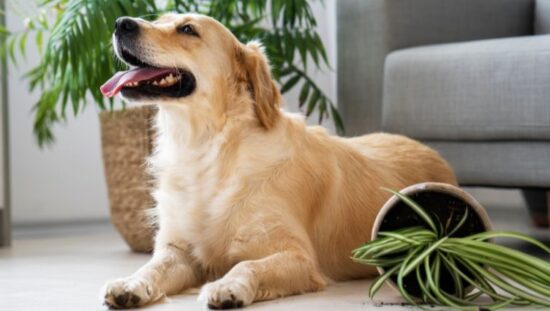Welcome to the ultimate guide to toilet training your furry friend! We have everything you need to help your dog master this essential skill, whether you’ve just adopted a puppy or you want to help an adult dog learn.
Training your dog to use the toilet can sometimes seem like a daunting task. But don’t worry! If you have patience, consistency, and the right approach, you can train your dog to do his business in the proper location every time.
Our guide will teach you everything you need to know about training your dog, from understanding his instincts to practical tips and tricks. So let’s start!

Learn to Identify Essential Potty Signals
Dogs have special ways of telling us when they need to go potty. Once you know what to look for, you can help your dog go to the right place, making your home cleaner and happier for everyone. So, let’s go through the signals:
- Pacing (when they walk back and forth restlessly),
- Sniffing (when they’re suddenly interested in every scent),
- Circling (when they start making circles before squatting),
- Whining (when they give a little cry or whimper).
These are their ways of saying, “Hey, I gotta go!” By catching these signs early, you can guide them to their potty spot just in time.
Dog Toilet Training Steps and Techniques
Teaching your dog where to go potty is important for keeping your home clean and your dog happy. With some patience and practice, you can help your dog learn where to do their business. Follow these steps to help them master this important skill:
1. Designate a Potty Area
Choose a spot outside where you want your dog to go potty. It can be a place that’s easy for both of you to get to. It could be a corner of your yard or a patch of grass. Take them to this spot regularly so they understand it’s their bathroom.
2. Establish a Routine
Having a routine means doing things at the same times every day. For potty training, it means taking your dog outside regularly. Start with first thing in the morning, after they eat, after they play, and before bed. Doing this every day helps your dog know when it’s time to go potty.
3. Watch for Signs
Keep an eye out for those potty signals we talked about earlier – pacing, sniffing, circling, and whining. When you see these signs, it’s time to take them outside to go potty.
4. Use Positive Reinforcement
When your dog goes potty in the right spot, tell them how good they are! You can also give them a treat or a special toy as a reward. As a result, your dog will know that they did something right and will want to do it again in the future.
5. Clean Up Accidents Properly
If your dog has an accident indoors, clean it up thoroughly with an enzymatic cleaner. This helps remove the smell so they won’t be tempted to go there again.
6. Be Patient
Remember, learning takes time, and your dog might have accidents at first. Stay calm and keep teaching them where to go potty. They’ll get better with practice.
7. Adjust as Needed
Every dog learns differently, so you might need to change your training a bit. Pay attention to what works and what doesn’t, and don’t be afraid to try new things. With patience and practice, your dog will learn where to go potty.
What to Do if Your Dog Has an Accident Indoors
Sometimes accidents happen, but don’t worry, we’ve got you covered on what to do!
It’s important not to get upset or scold your dog. They didn’t mean to make a mess. Take some paper towels and an enzymatic cleaner (you can find this at pet stores). Soak up as much as you can, then use the cleaner to make sure there’s no smell left. Dogs have a good sense of smell, and if they can still smell where they went potty before, they might think it’s okay to do it there again.
Don’t get mad at your dog if they have an accident. They won’t understand why you’re upset, and it might make them scared of you or going potty near you. It’s better to use positive words and rewards. When your dog goes potty in the right place, tell them how good they are; you can also give them a yummy treat. This helps them learn where they should go.
If your dog keeps having accidents, it might be time to think about your training techniques. Are you taking them outside enough? Are you looking for the signs that they need to go? You might need to change your plan a bit.
Special Considerations
Sometimes, we face unique challenges in toilet training. Here’s what you can do:
- Older Dogs- If you’re training an older dog, they might have some habits already. Be patient and consistent with your training. Take them out more often, especially after meals and before bedtime. And remember the praise and treats when they go potty in the right spot!
- Gastrointestinal Upsets- If your dog is having tummy troubles, accidents might happen more often. Keep an eye on them and take them out more often during this time. Also, try to stick to their regular feeding schedule and avoid giving them new foods that could upset their stomach.
- Medical Issues- Sometimes, accidents indoors could be a sign of a medical issue. If you see your dog starting to go potty more often or having accidents despite being trained, it’s a good idea to talk to your vet. They can check if any health issues are causing this change.
Advanced Training GroomHouse Tips
Are you ready to take your dog’s training to the next level? There’s an interesting trick called bell training. With bell training, you teach your dog to ring a bell when they need to go potty outside.
Here’s how it works: Hang a bell by the door to take your dog outside. When it’s potty time, you nudge the bell with their nose or paw. Then, you praise them and take them out. After doing this a lot of times, they’ll figure out that ringing the bell means it’s time for a potty break. It’s a fun way for your dog to tell you they need to go outside to do their business.
Also, there’s another cool method you can try. It’s called button training! You can teach your dog to press a special button when they need to go outside. It’s another way for them to tell you they gotta go. So, if you like this idea, you can try button training and see how it works for you and your furry friend!
Health and Hygiene
Keeping your dog’s living space clean is important for their health and well-being. This includes both their toilet area outside and the inside of your home.
Keeping your dog’s outdoor potty area clean is important. You have to pick up their poop regularly and clean the spot with water to keep it nice and fresh. Dogs like routine, so when their potty spot is clean, they know that’s where they’re supposed to go.
As we already mentioned, accidents can still happen inside the house, even if you’re doing your best to train your dog. But cleaning up those messes right away is really important. Use special cleaners that get rid of any smells that could make your dog want to go potty in the same place again.
If you keep your dog’s outdoor potty area and your home clean, you will make it easier for them to learn where to go potty. Plus, it will make your home a nicer place for both you and your dog to live in.
Frequently Asked Questions
1. How long does it take to toilet-train a dog?
Teaching your dog where to go potty takes time. Usually, it’s about 4 to 6 months, but every dog learns at their own speed. Some learn fast, while others need more time. Be patient and stick with it!
2. What age should a dog be toilet trained?
Most pups start learning when they’re around 12 weeks old. But some may learn earlier, and others might need a bit longer. It’s like how kids learn to use the potty at different ages. Just start when your pup is ready, and take it one step at a time.
3. What is the hardest dog to potty train?
Some breeds, like Dachshunds or Bulldogs, can be a bit trickier to train. It’s not because they’re bad dogs, just that they have their way of doing things! With patience and consistent training, though, any dog can learn where to go potty.
4. Do all dogs eventually get potty trained?
Yes, almost all dogs can learn with the right training. It might take longer for some pups, but they’ll get there. Just keep encouraging them and showing them the right spots to go. With your love and guidance, they’ll figure it out!
Conclusion
Teaching your dog where to go potty takes time and work, but it’s worth it! Every dog is different, just like people. Some learn fast, while others need more time. But if you’re patient and encouraging, they’ll learn.
The important thing is to stay positive and keep doing the same thing. When your dog does well, praise them, and gently correct them if they make a mistake. Remember, they’re still learning, just like you did when you were young.
Making a clean and comfortable spot for your dog to go potty is important too. It helps them know where to go and makes it easier for both of you. Plus, it keeps your home smelling nice!
So, enjoy the journey, celebrate the progress, and don’t worry too much if things don’t always go as planned. With your love and help, your dog will become a potty-training expert in no time!


